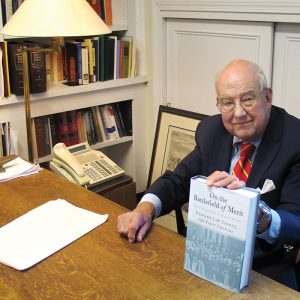Since their publication in 1840, James Madison’s notes on the framing of the Constitution have been seen as a reliable, real-time account of the 1787 Constitutional Convention. That will surely change thanks to Madison’s Hand (Harvard), a groundbreaking new study by Professor Mary Bilder, which reveals for the first time how thoroughly Madison revised the notes between the Convention and his death, in 1836. “Everyone—historians, political scientists, lawyers, judges—has used the revised text as if it were written in the summer of 1787, and the book makes it very difficult to do that from now on,” says Bilder.
Indeed, Madison’s Hand has garnered considerable attention in academia and the press and won a “book the year” nod from Legal Theory blogger Laurence Solum, for its revelatory thesis.
For her research, Bilder sought out Madison’s original manuscript, housed in the Library of Congress. What she found was a document with numerous changes—cross-outs, interpolated sentences, new text added on slips of paper that appear to have been pinned to the original. Comparing the notes with other delegates’ accounts, she realized that, while some revisions make the notes more accurate, others blur events to serve the future president’s political ends. (Madison wavered over publishing the notes during his political career.)
Many revisions to the notes hide Madison’s anger and annoyance with other Convention delegates, emotions that would have jumped off the pages of the unrevised version. Thus, “demagogue,” a term he used liberally, becomes “leading partisan,” and a delegate’s cockeyed reasoning becomes “able and close reasoning” that didn’t always, however, “accord with itself.”
Bilder urges special caution when it comes to the notes on Madison’s own speeches. Several appear on separate pages, in versions that Madison likely composed in 1789, she says. Some speeches, as revised, make Madison—by then a prominent member of Jefferson’s new Republican Party, which championed states’ rights—seem less a proponent of a powerful central government than he was at the Convention. In another speech, probably never given, Madison bitterly opposes the slave trade. In fact, while uneasy about slavery, he owned slaves and used slavery for leverage at the Convention, whipping up southern delegates’ fears that a new Constitution that empowered small states would also empower abolitionists.
Madison was “not far removed from folks like Karl Rove and George Stephanopoulos—the crowd that ends up on Sunday morning TV versus someone who might be interested in theoretical notions of the Good.”
Beyond the distortions introduced by latter-day revisions, the notes narrowly reflect their author’s interests. Madison was “not far removed,” says Bilder, “from folks like Karl Rove and George Stephanopoulos—the crowd that ends up on Sunday morning TV versus someone who might be interested in theoretical notions of the Good.” And since political deals most often get done in the legislature, the notes focus on debates about that branch, saying less about the executive and even less about the judiciary.
A final reason to tread carefully when reading the notes is that Madison was making changes even as he wrote them. Bilder theorizes that he used a set of “rough notes,” taken on the Convention floor, to compose a more coherent and grammatical text, if not an entirely accurate one, during breaks from the Convention. She points to his habit of translating speeches into language that sounded like his own rather than the speakers’. “He thought through problems as he wrote,” she says, “so how he wrote things down is a step removed from how they probably said them.”
Madison’s Hand is already being noticed by historians—one historian has called it “eye-opening,” while another calls it “the definitive study” of Madison’s notes—but it also has implications for law, casting doubt on the idea that the Framers’ intent can be divined by 21st century jurists. “If original understandings of the Convention existed, we cannot retrieve them,” as Bilder writes in her concluding chapter. “Indeed, hours after the Convention ended for the day, Madison could no longer recover it precisely for himself.”





